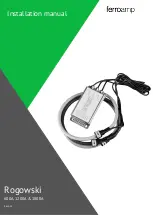
DW1000 User Manual
© Decawave Ltd 2017
Version 2.12
Page 25 of 242
3
Message Transmission
3.1 Basic Transmission
The transmission of data frames is one of the basic functions of the DW1000 transceiver. Figure 10 shows
the elements of the transmitted frame.
*Additional configurations marked “Extra” or “Extended” are proprietary to Decawave; see section 3.4 for details of
Figure 10: Transmit Frame format
The modulation details of these frame elements can be found
in section
10 – APPENDIX 1: The IEEE 802.15.4 UWB physical
The transmit sequence is as shown in Figure 11. The DW1000
begins in the
state awaiting instruction from the host
controller.
In order to transmit, the host controller must write data for
transmission to
Register file: 0x09 – Transmit Data Buffer
. The
desired selections for preamble length, data rate and PRF must
also be written to
Register file: 0x08 – Transmit Frame Control
Transmitter configuration is carried out in the
frame configurations may be carried out during active transmit
as described in section
Assuming all other relevant configurations have already been
made, the host controller initiates the transmission by setting
the TXSTRT control bit in
Register file: 0x0D – System Control
. After transmission has been requested, the DW1000
automatically sends the complete frame; preamble, SFD, PHR
and data. The FCS (CRC) is automatically appended to the
message as an aid to the MAC layer framing.
The end of frame transmission is signalled to the host via the
TXFRS event status bit in
Register file: 0x0F – System Event
new instructions.
Preamble
SFD PHR
Data
IEEE STD
:
64
,
1024
or
4096
symbols
*Extra
:
128
,
256
,
512
,
1536
or
2048
symbols
IEEE STD
:
8
or
64
symbols
*Extra
:
16
symbols
21
bits
IEEE STD
:
Up to
127
coded octets
*Extended
:
Up to
1023
coded octets
NO
TX
complete
?
NO
YES
AUTOSLEEP
?
Write Tx data to data buffer
Configure Tx parameters
Transmit message
TX START
?
TRANSMIT
YES
IDLE
YES
SLEEP
Figure 11: Basic Transmit Sequence
















































